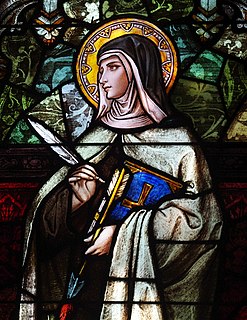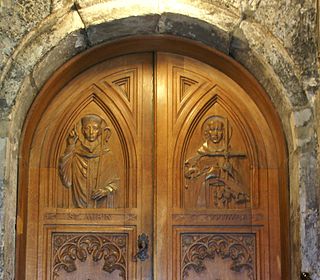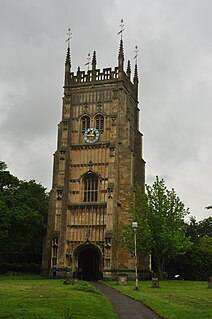
In religious belief, a saint is a person who is recognized as having an exceptional degree of holiness, likeness, or closeness to God. However, the use of the term saint depends on the context and denomination. In Catholic, Eastern Orthodox, Anglican, Oriental Orthodox, and Lutheran doctrine, all of their faithful deceased in Heaven are considered to be saints, but some are considered worthy of greater honor or emulation. Official ecclesiastical recognition, and consequently a public cult of veneration, is conferred on some denominational saints through the process of canonization in the Catholic Church or glorification in the Eastern Orthodox Church after their approval.

Edgar, known as the Peaceful or the Peaceable, was King of the English from 959 until his death in 975. The younger son of King Edmund I and Ælfgifu of Shaftesbury, he came to the throne as a teenager following the death of his older brother, King Eadwig. As king, Edgar further consolidated the political unity achieved by his predecessors, with his reign being noted for its relative stability. His most trusted advisor was Dunstan, whom he recalled from exile and made Archbishop of Canterbury. The pinnacle of Edgar's reign was his coronation at Bath in 973, which was organised by Dunstan and forms the basis for the current coronation ceremony. After his death he was succeeded by his son Edward, although the succession was disputed.

Margaret, known as Margaret of Antioch in the West, and as Saint Marina the Great Martyr in the East, is celebrated as a saint on 20 July in the Western Rite Orthodoxy, Roman Catholic Church and Anglicanism, on 17 July by the Eastern Orthodox Church and on Epip 23 and Hathor 23 in the Coptic Orthodox Church of Alexandria.

Gall according to hagiographic tradition was a disciple and one of the traditional twelve companions of Columbanus on his mission from Ireland to the continent. Deicolus was the elder brother of Gall.

Saint Mirin was born in 565, is also known as Mirren of Benchor, Merinus, Merryn and Meadhrán. The patron saint of the town and Roman Catholic diocese of Paisley, Scotland, he was the founder of a religious community which grew to become Paisley Abbey. The shrine of this saint in the abbey became a centre of pilgrimage.

Simeon at the Temple is the "just and devout" man of Jerusalem who, according to Luke 2:25–35, met Mary, Joseph, and Jesus as they entered the Temple to fulfill the requirements of the Law of Moses on the 40th day from Jesus' birth, i. e. the presentation of Jesus at the Temple.
Ælfthryth, also known as Alfreda,Alfritha, Aelfnryth, or Etheldritha, is a saint, virgin, and recluse, venerated in both the Roman Catholic Church and Antiochian Orthodox Church. She was a daughter of King Offa of Mercia and his consort, Cynethryth.

Saint Austregisilus was bishop of Bourges from 612 to 624. His feast day is 20 May.

Saint Landelin is a saint in the Eastern Orthodox Church and Roman Catholic Church. He was a former brigand who underwent a Christian conversion. As a result of this, in about 650 he founded a monastery at Lobbes in Hainaut - Lobbes Abbey - in order to make amends to the area which he had formerly injured.

Tudyof Landevennec was a Breton saint of the 5th or 6th century. He was a hermit who founded monasteries at Landévennec in Brittany, France and in Cornwall, England. The village of St Tudy in Cornwall is named for him. He may have been a disciple of Saint Maudez, after whom St Mawes is named. His companions may have included Saint Corentinus and Saint Brioc. Île-Tudy, on the mouth of the Odet, is named after him.
Saint Ada is a saint from Le Mans, France. In the 7th-century, she served the Christian church as the abbess of the St. Julien de Prés Abbey in Le Mans. Previously she had been as a nun in the city of Soissons. Though she is best known as Saint Ada of Le Mans, her place of patronage is sometimes given as Soissons or St. Julien, and her given name is sometimes recorded as Adeneta, Adna, Adneta, Adnetta, Adonette, Adrechild, Adrehilda, Adrehilde, or Adrehildis. The Saint loved God very much and lived her life with hope.
Sigo was a Burgundian abbot of the sixth century. He is a saint of the Roman Catholic Church, an Orthodox saint and the reputed founder of the Abbey of Saint-Seine and in the Orthodox Church.

Anthony the Hermit, also known as Anthony of Lérins, is a Christian saint. He was born in the ancient Roman province of Valeria, then part of the Hunnic Empire. When he was eight years old, his father died and he was entrusted to the care of the holy Abbot Severinus of Noricum, in modern-day Austria. Upon the death of Severinus in 482, Anthony was sent to Germany and put in the care of his uncle, Constantius, an early Bishop of Lorsch. While there, Anthony is thought to have become a monk at the age of twenty.

Hidulf was an abbot, founder of Moyenmoutier Abbey, and reputed bishop of Trier. He may have been born in Regensburg.
Bladulf, was a monk and priest of Bobbio Abbey, killed at the orders of the Lombard king Arioald, who was an Arian.
Gurthiern was a Welsh prince. According to the Vita sancta Gurthierni, he became a hermit in Brittany and founder of an abbey at Kemperle (Quimperlé). He is a Catholic and Orthodox saint with a feast day on 3 July.

Saint Credan of Evesham is a saint in the calendar of the Roman Catholic Church and of the Eastern Orthodox Church. He is also known in Latin as Credus or Credanus.

Saint Bavo of Ghent is a Roman Catholic and Eastern Orthodox saint. He was the son of Pepin of Landen and the brother of saints Begga and Gertrude of Nivelles.
Saint Martin of Arades, also called Martin of Corbie, was a canonized monk from Corbie Abbey, whose feast day is November 26 in both the Roman Catholic and the Eastern Orthodox Church.
Saint Severus of Vienne was a priest who evangelised in Vienne, France. He is venerated as a Catholic saint. Severus is said to have been Indian by birth and of wealthy origins. His entry in the Roman Martyrology reads:
'At Vienne, in France, St. Severus, priest and confessor, who undertook a painful journey from India in order to preach the Gospel in that city, and converted a great number of Pagans to the faith of Christ by his labors and miracles.'













